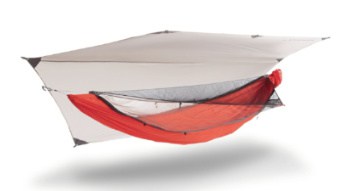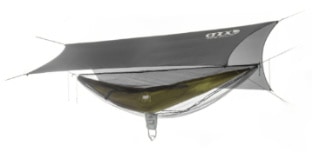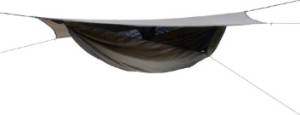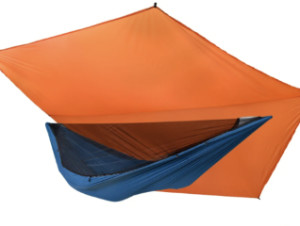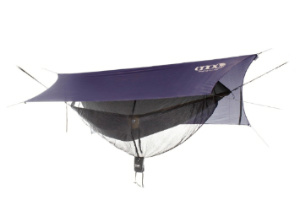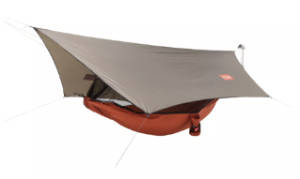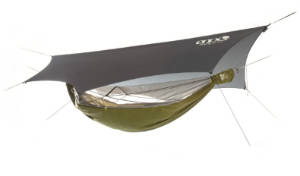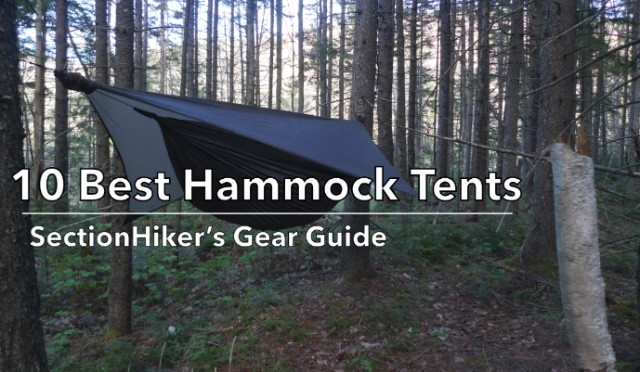
All-in-One Hammocks Tent Systems, also known as camping hammocks, backpacking hammocks, and hammock shelter systems are complete shelters that include a hammock, mosquito netting, a tarp for rain protection, and a suspension system to hang it all between two trees. The biggest advantage of buying an all-in-one hammock tent is that all the components fit together and you can take them out on the trail having confidence that they will work together as intended. That’s particularly useful if this is your first hammock setup, so you can learn the ropes. You can also purchase each component separately from a wide range of manufacturers, both large and small, but that can be an expensive trial-and-error process. I know this first-hand.
Here are 10 Best All-in-One Hammock Tent Systems we recommend:
| Make / Model | Height Limit | Weight Limit | Trail Weight |
|---|---|---|---|
| Kammok Mantis Ultralight All-in-One Hammock Tent | 6' 4" | 300 lbs | 35 oz |
| Hammock Gear Wanderlust | 6' 4" | 300 lbs | 40 oz |
| ENO SubLink Hammock Shelter System | 6' | 250 lbs | 35 oz |
| Hennessey Hammock Explorer Deluxe Asym Zip | 7' | 300 lbs | 51 oz |
| Dutchware Wide Netted Hammock Package | 6' 1" | 350 lbs | 43.2 oz |
| ENO OneLink Hammock Shelter System | 6' | 400 lbs | 63 oz |
| Hennessy Hammock Ultralite Backpacker Asym Zip | 6' 5" | 265 lbs | 31 oz |
| Grand Trunk Air Bivy | 6' 5" | 400 lbs | 63 oz |
| Lawson Blue Ridge Hammock Tent | 7' | 250 lbs | 68 oz |
| ENO JungleLink Hammock System | 6' 5" | 300 lbs | 48 oz |
The advantage of sleeping in a hammock is that makes it much easier to find great campsites on the fly, particularly in heavily forested or mountainous terrain, where flat open campsites are few and far between. Once you get accustomed to sleeping in a hammock, you’ll be surprised at the quality of sleep you can get compared to sleeping on the ground.
1. Kammok Mantis Ultralight All-in-One Hammock Tent
2. Hammock Gear Wanderlust Complete Kit for Hammock Camping
3. ENO SubLink Hammock Shelter System
| Shop at REI | Shop at Amazon |
4. Hennessy Hammock Explorer Deluxe Asym Zip
5. Dutchware Wide Netted Hammock Package
6. ENO OneLink Hammock Shelter System
| Shop at REI | Shop at Amazon |
7. Hennessy Hammock Ultralite Backpacker Asym Zip Hammock
8. Grand Trunk Air Bivy All Weather Shelter and Hammock
9. Lawson Blue Ridge Hammock
10. ENO JungleLink Hammock System
| Shop at REI | Shop at Amazon |
Key Considerations for Hammock Tents
Buying a complete hammock shelter system is a quick way to try hammock camping and backpacking to see if it’s right for you. The nice thing about all of the kits listed here is that they include everything you need to sleep in a hammock, soup to nuts, without having to acquire additional components. That can be a tricky process when you’re new to hammocking and you can end up buying some incompatible gear.
Backpacking vs Camping Hammock Tent Systems
Hammock systems designed for backpacking are usually lighter weight than those designed for base camping or car camping. The features and functions are largely the same, but lighter-weight fabrics are used for backpacking hammock systems and they tend to be somewhat more expensive.
Single or Double Layer Hammocks
Most people need insulation under their backs when sleeping in a hammock if its; less than 70 degrees outside. If you have a single-layer hammock you can sleep on top of a foam pad or suspend an underquilt underneath the hammock body. Inflatable pads don’t work that well because they’re hard to hold in place underneath you when you’re hanging in the air. Double layer hammocks have an internal sleeve under the sleeping surface, so you can tuck a sleeping pad into it to keep it out of the living space. The sleeve can also hold a foam or an inflatable sleeping pad. But the extra fabric layer on double layer hammocks does add to their weight.
Webbing, Daisy Chain, or Whoopie Sling Suspension Systems for Hammocks
There are three common types of suspension systems for hanging a hammock. Some shelters come with polyester webbing straps that you wrap around a tree and then hook your hammock too directly with a carabiner or a metal hook. Some add daisy chains to the webbing that you can clip your hammock to, and some use a knotless tensioning system called a Whoopie sling (which works like a Chinese finger trap) to attach a hammock to the webbing straps. All three work fine and the only real difference between them is usually gear weight, with the Whoopie sling being the lightest weight system.
Tarp Suspension Systems
Most tarps require a suspension system that is separate from the one that suspends the hammock between two trees. Most of the hammock tarps listed above have a knotless setup, with cord tensioners at the ends of the ridgeline and on the side guy lines for setup. This really expedites set-up times.
Gathered End Hammocks
Hammocks that have bunched ends and a banana shape are called gathered-end hammocks and are commonly used on hammocks intended for backpacking. Long (length) gathered-end hammocks are better than shorter ones if you prefer sleeping flat, as you would on a bed, rather than with a back curved like a banana. An 11′ foot long hammock is considered long, while a 9′ hammock would be considered moderately short.
Mosquito Netting
Many hammocks have sewn-in mosquito netting, while it is zippered in, or even removable on others. If you get a hammock without mosquito netting, you can get a standalone net that slides on over one end of the hammock that you pull over the head end or one that zippers closed on top. They’re all just as effective and what you get is usually a matter of personal choice and how much insect protection you need.
Internal Gear Storage
It’s really nice to have a pocket or two for internal gear storage in a hammock, even if it’s just for your keys and a smartphone. Most of your gear will have to be stored outside the hammock, usually on the ground, unless you get a gear sling to suspend it underneath your hammock.
Distance between Tarp/Rain Cover and the Hammock
If you plan to use one of the above hammock tent systems in hot or humid weather, consider getting one with an adjustable air gap between the tarp/rain cover and the hammock. Good airflow is necessary to combat the transfer of condensation from your tarp into the hammock and onto your sleeping insulation.
SectionHiker is reader-supported. We only make money if you purchase a product through our affiliate links. Help us continue to test and write unsponsored and independent gear reviews, beginner FAQs, and free hiking guides.Check Out All of SectionHiker's Gear Guides!
- 10 Best Hiking Shoes and Trail Runners
- 10 Best 2-Person Backpacking Tents
- 10 Best 1-Person Backpacking Tents
- 10 Best Backpacking Stoves
- 10 Best Backpacking Water Filters
- 10 Best Lightweight Backpacks
- 10 Best Ultralight Backpacks
- 10 Best Backpacking Sleeping Bags
- 10 Best Ultralight Backpacking Quilts
- 10 Best Lightweight Backpacking Chairs
- 10 Best Backpacking Sleeping Pads
- 10 Best Backpacking Rain Jackets
- 10 Best Hiking Daypacks
- 10 Best Hiking Pants
- 10 Best Trekking Poles
 SectionHiker.com Backpacking Gear Reviews and FAQs
SectionHiker.com Backpacking Gear Reviews and FAQs 